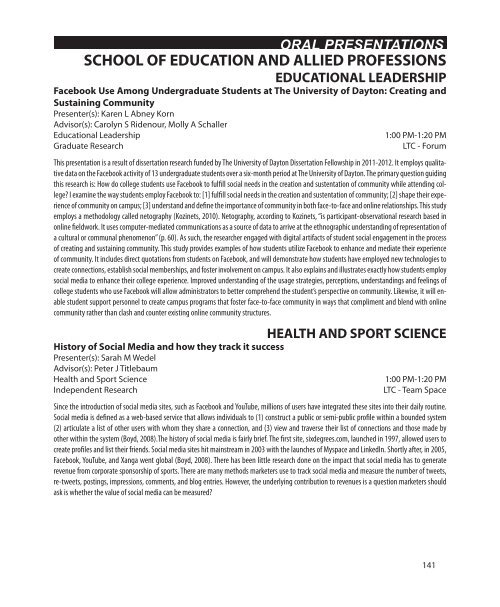Stander Symposium abstract book - University of Dayton
Stander Symposium abstract book - University of Dayton
Stander Symposium abstract book - University of Dayton
You also want an ePaper? Increase the reach of your titles
YUMPU automatically turns print PDFs into web optimized ePapers that Google loves.
ORAL PRESENTATIONS<br />
SCHOOL OF EDUCATION AND ALLIED PROFESSIONS<br />
EDUCATIONAL LEADERSHIP<br />
Face<strong>book</strong> Use Among Undergraduate Students at The <strong>University</strong> <strong>of</strong> <strong>Dayton</strong>: Creating and<br />
Sustaining Community<br />
Presenter(s): Karen L Abney Korn<br />
Advisor(s): Carolyn S Ridenour, Molly A Schaller<br />
Educational Leadership<br />
Graduate Research<br />
1:00 PM-1:20 PM<br />
LTC - Forum<br />
This presentation is a result <strong>of</strong> dissertation research funded by The <strong>University</strong> <strong>of</strong> <strong>Dayton</strong> Dissertation Fellowship in 2011-2012. It employs qualitative<br />
data on the Face<strong>book</strong> activity <strong>of</strong> 13 undergraduate students over a six-month period at The <strong>University</strong> <strong>of</strong> <strong>Dayton</strong>. The primary question guiding<br />
this research is: How do college students use Face<strong>book</strong> to fulfill social needs in the creation and sustentation <strong>of</strong> community while attending college?<br />
I examine the way students employ Face<strong>book</strong> to: [1] fulfill social needs in the creation and sustentation <strong>of</strong> community; [2] shape their experience<br />
<strong>of</strong> community on campus; [3] understand and define the importance <strong>of</strong> community in both face-to-face and online relationships. This study<br />
employs a methodology called netography (Kozinets, 2010). Netography, according to Kozinets, “is participant-observational research based in<br />
online fieldwork. It uses computer-mediated communications as a source <strong>of</strong> data to arrive at the ethnographic understanding <strong>of</strong> representation <strong>of</strong><br />
a cultural or communal phenomenon” (p. 60). As such, the researcher engaged with digital artifacts <strong>of</strong> student social engagement in the process<br />
<strong>of</strong> creating and sustaining community. This study provides examples <strong>of</strong> how students utilize Face<strong>book</strong> to enhance and mediate their experience<br />
<strong>of</strong> community. It includes direct quotations from students on Face<strong>book</strong>, and will demonstrate how students have employed new technologies to<br />
create connections, establish social memberships, and foster involvement on campus. It also explains and illustrates exactly how students employ<br />
social media to enhance their college experience. Improved understanding <strong>of</strong> the usage strategies, perceptions, understandings and feelings <strong>of</strong><br />
college students who use Face<strong>book</strong> will allow administrators to better comprehend the student’s perspective on community. Likewise, it will enable<br />
student support personnel to create campus programs that foster face-to-face community in ways that compliment and blend with online<br />
community rather than clash and counter existing online community structures.<br />
HEALTH AND SPORT SCIENCE<br />
History <strong>of</strong> Social Media and how they track it success<br />
Presenter(s): Sarah M Wedel<br />
Advisor(s): Peter J Titlebaum<br />
Health and Sport Science<br />
Independent Research<br />
1:00 PM-1:20 PM<br />
LTC - Team Space<br />
Since the introduction <strong>of</strong> social media sites, such as Face<strong>book</strong> and YouTube, millions <strong>of</strong> users have integrated these sites into their daily routine.<br />
Social media is defined as a web-based service that allows individuals to (1) construct a public or semi-public pr<strong>of</strong>ile within a bounded system<br />
(2) articulate a list <strong>of</strong> other users with whom they share a connection, and (3) view and traverse their list <strong>of</strong> connections and those made by<br />
other within the system (Boyd, 2008).The history <strong>of</strong> social media is fairly brief. The first site, sixdegrees.com, launched in 1997, allowed users to<br />
create pr<strong>of</strong>iles and list their friends. Social media sites hit mainstream in 2003 with the launches <strong>of</strong> Myspace and LinkedIn. Shortly after, in 2005,<br />
Face<strong>book</strong>, YouTube, and Xanga went global (Boyd, 2008). There has been little research done on the impact that social media has to generate<br />
revenue from corporate sponsorship <strong>of</strong> sports. There are many methods marketers use to track social media and measure the number <strong>of</strong> tweets,<br />
re-tweets, postings, impressions, comments, and blog entries. However, the underlying contribution to revenues is a question marketers should<br />
ask is whether the value <strong>of</strong> social media can be measured?<br />
141

















